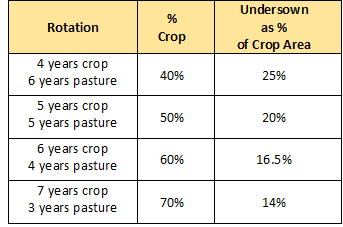Getting Paddock Rotations Right
Increasingly mixed farming operations are finding there are a number of paddocks in the system that have been cropped for an extended period of time. These paddocks are generally more costly, because they require more inputs, often have more weed problems and yield less than paddocks in a structured rotation. In many cases this is a legacy of drought years, where failed undersown paddocks were brought back into crop, without additional area being undersown in the following years.
In a crop/pasture rotation, a certain percentage of the cropped area needs to be undersown in any one year, with a corresponding area being brought from pasture into crop to keep the system in a steady state. The following Table shows the undersown percentage required to maintain a steady state, based on cropping a certain percentage of the farm.
If there are a number of paddocks in the system with a long cropping history and each year less than the required undersown area is sown, then it is impossible to ever get to a point where the system is operating at the desired level.
The only way to break this cycle is to play catch up over one or more years. To do this the area of undersown needs to be increased, above that required for the steady state.
The issues associated with this approach are:
Additional pasture seed cost
Reduced yield from cover crops
Risk of failure
However the issues associated with not doing it are:
Increasing input costs
Consistently lower crop yields with declining grain protein
Bringing poor, weedy pastures into crop rather than strong clean pastures
Lower stocking rates
Higher financial risk
The reality is that there is no way of getting to the desired rotation, other than by increasing the undersown area.
There are a number of strategies that can be used to reduce the risk and financial impact. These include:
Undersowing canola. This allows improved management of grass weeds, reduces risk of failure as canola finishes earlier, with often minimal yield reduction. Note that when undersowing with canola there are no broadleaf weed control options
Reducing cover crop rate to 12-15kg/ha of cereal seed. This will impact on top end yield, but will yield equally well in a dry year and significantly reduces the risk of pasture failure.
For cereal undersown, a short maturing variety which is not competitive should be used
Sowing early. This allows the pasture to establish prior to colder conditions in winter, which increases the success of establishment
Topdressing the paddock with a low rate of Urea. This benefits both the crop and the establishing pasture
Not grazing the new pasture until after the opening rains the following year. The feed gained from a new pasture over the first summer is insignificant, compared to the damage that can be done and the long term effects on the pasture’s productivity. The un-grazed new pastures make ideal lambing paddocks the following year


